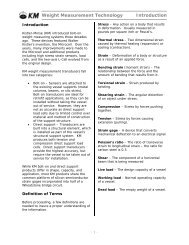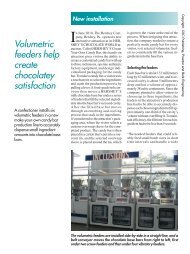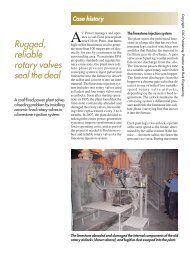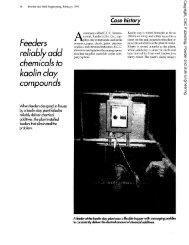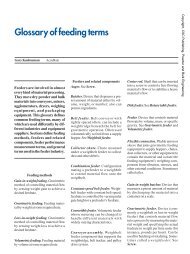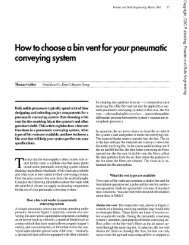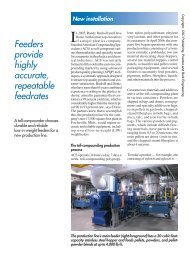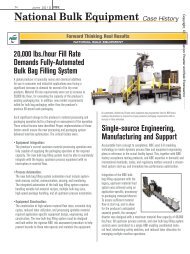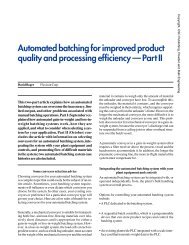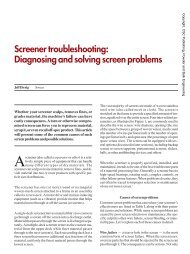How to select and maintain an aeromechanical conveyor
How to select and maintain an aeromechanical conveyor
How to select and maintain an aeromechanical conveyor
- TAGS
- aeromechanical
- conveyor
Create successful ePaper yourself
Turn your PDF publications into a flip-book with our unique Google optimized e-Paper software.
Copyright, CSC Publishing, Powder <strong><strong>an</strong>d</strong> Bulk EngineeringFigure 4Rope in contact with sprocket <strong><strong>an</strong>d</strong> discs meshing withpockets in sprocket rimSprocketSprocketrimDiscsRopefected by such fac<strong>to</strong>rs as the <strong>conveyor</strong> run time, start <strong><strong>an</strong>d</strong>s<strong>to</strong>p frequency, the <strong>conveyor</strong> length, your material’s characteristics,<strong><strong>an</strong>d</strong> the solids-<strong>to</strong>-air ratio. Without regular inspection<strong><strong>an</strong>d</strong> tensioning, the rope c<strong>an</strong> wear <strong><strong>an</strong>d</strong> breakprematurely, resulting in unpl<strong>an</strong>ned downtime for replacingthe entire rope-<strong><strong>an</strong>d</strong>-disc assembly or sections of it.Properly tensioning the rope will ensure that the rope-<strong><strong>an</strong>d</strong>discassembly has a longer service life. Your operations<strong><strong>an</strong>d</strong> mainten<strong>an</strong>ce m<strong>an</strong>ual will include detailed instructionsfor tensioning the rope at proper time intervals. The conventionalm<strong>an</strong>ual method for adjusting the rope tensiontypically requires a mainten<strong>an</strong>ce worker <strong>to</strong> check the ropetension at 1-, 4-, 8-, <strong><strong>an</strong>d</strong> 50-hour intervals after the <strong>conveyor</strong>is initially started, <strong><strong>an</strong>d</strong> then after every 100 hours ofoperation or as needed. M<strong>an</strong>ually checking the rope tensionis a multistep process: emptying <strong><strong>an</strong>d</strong> s<strong>to</strong>pping the<strong>conveyor</strong>; opening the inlet (bot<strong>to</strong>m) sprocket accessdoor; examining the inlet sprocket <strong>to</strong> see if the rope is contactingthe sprocket rather th<strong>an</strong> sagging from it; openingthe outlet (<strong>to</strong>p) sprocket access door; <strong><strong>an</strong>d</strong> checking the outletsprocket for slippage between the rope <strong><strong>an</strong>d</strong> sprocket. Ifthe rope is loose, the worker must tension it m<strong>an</strong>ually, typicallyby sliding the outlet sprocket (which is usually therope-tensioning sprocket) housing along the <strong>conveyor</strong>tube <strong>to</strong> stretch the rope until the rope at the inlet sprocketfits snugly on that sprocket.An alternative <strong>to</strong> m<strong>an</strong>ual tensioning is a recently developedau<strong>to</strong>matic rope-tensioning system 1 that keeps therope properly tensioned while requiring signific<strong>an</strong>tly lesstime <strong><strong>an</strong>d</strong> labor th<strong>an</strong> the m<strong>an</strong>ual method. The au<strong>to</strong>maticsystem includes a tensioning device (<strong>an</strong> electric or pneumaticlinear actua<strong>to</strong>r), a load cell that c<strong>an</strong> be integrated in<strong>to</strong>the <strong>conveyor</strong>’s control system, <strong><strong>an</strong>d</strong> a position control device.The tensioning device is mounted parallel <strong>to</strong> <strong><strong>an</strong>d</strong> betweenthe <strong>conveyor</strong> tubes near the outlet housing, the loadcell is mounted between one <strong>conveyor</strong> tube <strong><strong>an</strong>d</strong> the tensioningdevice, <strong><strong>an</strong>d</strong> the position control device is linked <strong>to</strong>the tensioning device. Each time the aeromech<strong>an</strong>ical <strong>conveyor</strong>is shut down, the load cell au<strong>to</strong>matically measuresthe rope tension, <strong><strong>an</strong>d</strong>, when the tension requires adjusting,the tensioning device moves the outlet housing <strong>to</strong> a positionwhere the rope reaches the correct tension. The positioncontrol device provides feedback about the tensioningdevice’s location <strong><strong>an</strong>d</strong> c<strong>an</strong> also be used <strong>to</strong> indicate when therope is worn. The au<strong>to</strong>matic system’s reduction of ropetensioningtime <strong><strong>an</strong>d</strong> labor results in lower <strong>conveyor</strong> mainten<strong>an</strong>ce<strong><strong>an</strong>d</strong> operating costs.Cle<strong>an</strong>ing your <strong>conveyor</strong>. Periodically, you’ll need <strong>to</strong>cle<strong>an</strong> out material residue from the empty <strong>conveyor</strong>. Drycle<strong>an</strong>ing the <strong>conveyor</strong> with a vacuum cle<strong>an</strong>ing system issuitable in some applications, but in most applications the<strong>conveyor</strong> must be washed using <strong>an</strong> integrated cle<strong>an</strong>-inplacesystem with a suitable cle<strong>an</strong>ing fluid, then dried byrunning the <strong>conveyor</strong> for a period while it’s empty. The<strong>conveyor</strong> typically has multiple access p<strong>an</strong>els <strong><strong>an</strong>d</strong> doorsthat allow workers <strong>to</strong> insert dry cle<strong>an</strong>ing equipment orconnect <strong><strong>an</strong>d</strong> drain a cle<strong>an</strong>-in-place system. The rope’s constructionof multiple steel str<strong><strong>an</strong>d</strong>s c<strong>an</strong> make the rope difficult<strong>to</strong> cle<strong>an</strong>, but this is typically only a concern when youmust frequently ch<strong>an</strong>ge materials <strong><strong>an</strong>d</strong> avoid cross-contaminationbetween batches; <strong>an</strong>other type of <strong>conveyor</strong> c<strong>an</strong>be better suited <strong>to</strong> such <strong>an</strong> application.PBEReference1. Dynamic Au<strong>to</strong>matic Rope-Tensioning (DART) system, available fromSpiroflow Systems Inc., Monroe, N.C. (www.spiroflowsystems.com).For further readingFind more information on aeromech<strong>an</strong>ical <strong>conveyor</strong>s inarticles listed under “Mech<strong>an</strong>ical conveying” in Powder<strong><strong>an</strong>d</strong> Bulk Engineering’s comprehensive article index atwww.powderbulk.com <strong><strong>an</strong>d</strong> in the December 2006 issue.David Hesketh is vice president of engineering atSpiroflow Systems Inc., 2806 Gray Fox Road, Monroe, NC28110; 704-291-9595, fax 704-291-9594 (davehesketh@spiroflowsystems.com, www.spiroflowsystems.com). He holds a BSc in design <strong><strong>an</strong>d</strong> m<strong>an</strong>ufacturefrom University of Central L<strong>an</strong>cashire, Engl<strong><strong>an</strong>d</strong>, <strong><strong>an</strong>d</strong> has20 years experience in bulk material h<strong><strong>an</strong>d</strong>ling.





